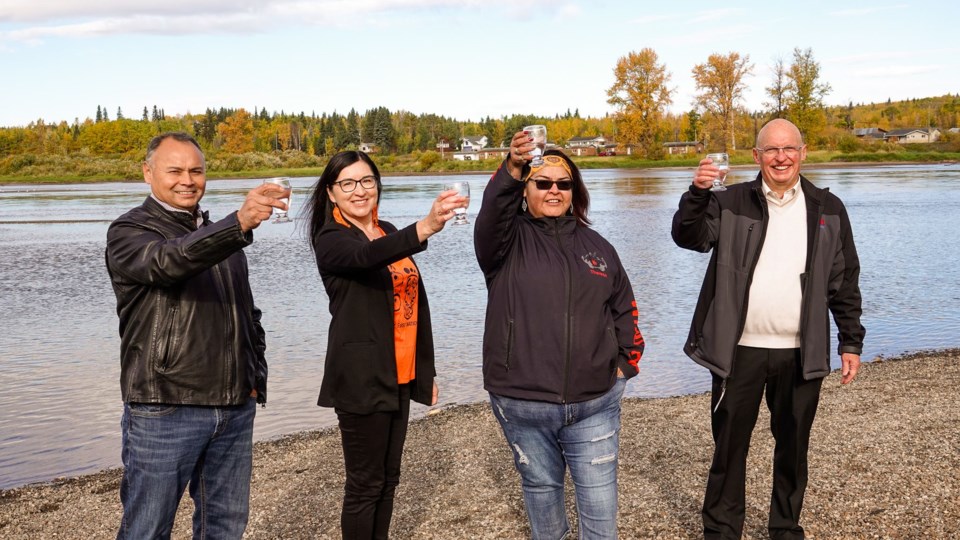Sometime in the spring of 2022, several Nechako River First Nations hope the BC Supreme Court will rule in their favour in a lawsuit against Rio Tinto Alcan Inc. that would address their concerns about the health of the river.
But they are also hoping for a compromise that would restore river flows to the Nechako without having to remove the Kenney Dam and shut down Rio Tinto’s BC Works aluminum smelter in Kitimat.
Chief Priscilla Mueller of the Saik’uz First Nation said Rio Tinto has lately shown some willingness to listen to the concerns of First Nations, which are focused mainly on the negative impact the dam and low river flows have had on salmon and sturgeon.
“We’ve never had a relationship with Rio Tinto, and I really believe now that we’re building a relationship,” Mueller said. “They’ve been out to our Nechako First Nations communities and those meetings were positive.”
The Nechako River was dammed in the 1950s to generate power for the Kitimat aluminum smelter.
Depending on the time of year, the Kenney Dam can reduce river flows to 25% of what they would be without the dam. In drier years, that can be a serious problem for fish.
“We literally have no salmon left,” Mueller said. “And the sturgeon, everybody knows that they’re becoming extinct. Today, we have to buy our salmon, which is very, very sad for our communities. This was our livelihood.”
The Nechako First Nations’ BC Supreme Court case claims that the dam has had a negative impact on their Aboriginal rights. If the court rules in their favour, it could have economic fallout for Kitimat’s biggest employer: the BC Works aluminum smelter, which employs roughly 1,000 people.
Somewhere between the interests of industry and jobs and the interests of the environment, fish and First Nations, there may be a compromise. Ideally, for the river and its fish, the Kenney Dam would be removed, allowing the river to be restored to normal flow levels. That’s not what the First Nations expect the BC Supreme Court will order. But they hope the court will recognize the impacts the dam has had on the river, fish and livelihoods of Nechako First Nations and recommend a plan to restore at least some of the river’s natural flow levels.
“There is a real opportunity to keep the smelter running 100% and restore natural flow in the river, and that’s what the nations are trying to get to,” said Alex Grzybowski, an adviser to the Nechako First Nations.
The biggest concern about river levels is in the springtime, when levels would typically be at a seasonal high. In drier years, to maintain sufficient river flows, water could be spilled over the dam. Rio Tinto would have to forgo some power generation, but could buy the power it needs from BC Hydro. The Kemano Generating Station already produces more power than the smelter needs. Rio Tinto sells some of that surplus power to BC Hydro. Since the new Site C dam is expected to produce a power surplus, there should be sufficient generating capacity to sell power to the Rio Tinto when water needs to be held back in the spring.
Should such an arrangement be agreed to – or enforced by the court – it would require an amendment to, or replacement of, the 1987 Settlement Agreement, which governs Nechako water flows and release. Rio Tinto is bound by that agreement.
A new governance model being proposed by the Regional District of Bulkley-Nechako (RDBN) and the Saik’uz, Stellat’en, and Nadleh Whut’en First Nations appears to anticipate some new agreement for the Nechako – one that includes First Nations.
Earlier this year, the RDBN and the Nechako First Nations signed a memorandum of understanding aimed at giving those parties a seat at the Nechako River governance table.
Rio Tinto appears to be at least listening to the concerns of the Nechako First Nations.
“For the past three years we have been working with a variety of parties at the Water Engagement Initiative for the benefit of the Nechako River,” a spokesman for Rio Tinto said in a written statement. “We are committed to working with the Nechako First Nations, other First Nations, government and stakeholders to review all aspects of the Nechako Reservoir management process.”



